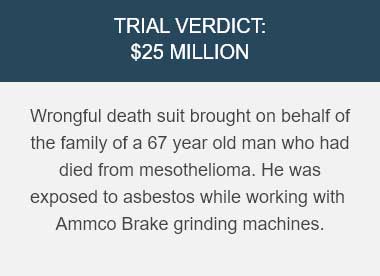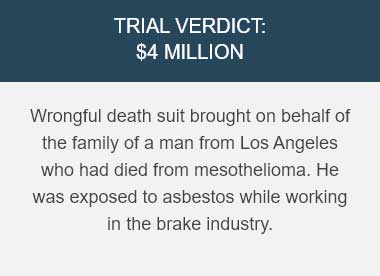Mesothelioma is a very rare cancer, but it’s an incredibly dangerous disease that takes such a long time to show signs in the body that by the time it’s diagnosed, the median survival rate is just 15 months (National Mesothelioma Virtual Bank).
Typical latency periods for mesothelioma span a huge range, 20 to 50 years, but there are many factors that impact that period of time, and there are several reasons why latency periods for this particular type of cancer tend to be so long.
Causes of Mesothelioma Cancer
While mesothelioma can be caused by a few substances, there’s a single one that has been pegged as the cause of the vast majority of cases — asbestos. This harmful substance that’s been banned in many countries is estimated to account for about 80% of all cases of mesothelioma.
That’s a key reason why people who worked for years in occupations where they were regularly exposed to the substance have higher incidence and death rates of mesothelioma than other people, particularly insulators, pipefitters and other construction workers (Centers for Disease Control and Prevention).
But it’s important to note that while asbestos is the primary culprit of the majority of mesothelioma cases, it’s not the only cause, and the prevalence of this type of cancer in people with no known exposure to asbestos is being further studied. Here’s what we know so far about some of the other accepted or suspected causes (Archives of Pathology & Laboratory Medicine):
- Erionite: A mineral with fibrousness similar to asbestos has been linked in animal studies to mesothelioma. One study showed that mesothelioma developed in more than 90% of rats exposed to the mineral.
- Radiation treatment: Medical exposure to radiation, such as for cancer treatment or X-rays, may be a cause. An analysis of Hodgkin lymphoma survivors who had radiation therapy found they had mesothelioma at 30 times the rate of all people.
- Others: Several other substances have been implicated in animal studies, including nickel, beryllium and silica.
Mesothelioma Cancer Rates
Less than 3,000 people are diagnosed with mesothelioma every year in the U.S., making it a very rare cancer. For comparison’s sake, about 280,000 women will get a breast cancer diagnosis this year (American Cancer Society).
Mesothelioma cases have fluctuated in recent years, but by sheer numbers, cases have increased modestly since 1999, rising by just under 5% through 2015. But the number of cases has gone down from a high of 2,873 in 2012 (Centers for Disease Control and Prevention).
Mesothelioma cases by year
| 1999 | 2,479 |
| 2000 | 2,529 |
| 2001 | 2,504 |
| 2002 | 2,570 |
| 2003 | 2,621 |
| 2004 | 2,656 |
| 2005 | 2,701 |
| 2006 | 2,586 |
| 2007 | 2,603 |
| 2008 | 2,706 |
| 2009 | 2,752 |
| 2010 | 2,744 |
| 2011 | 2,829 |
| 2012 | 2,873 |
| 2013 | 2,686 |
| 2014 | 2,785 |
| 2015 | 2,597 |
Unfortunately, mesothelioma is far more deadly than many other types of cancer, partially because the latency period for this cancer is so long. The average five-year survival rate for mesothelioma is just 10%, compared to 98% for prostate and thyroid cancer, 92% for melanoma, 90% for breast cancer and 64% for colorectal cancer (Cancer Statistics Center).
Mesothelioma Latency Factors
Studies have suggested that several factors play a role in the delay between exposure and diagnosis of mesothelioma, and while some are in an individual’s control, most of them are largely unavoidable once exposure has occurred.
Here’s a look at what the best available medical literature tells us about the major factors influencing mesothelioma latency:
- Other conditions: Mesothelioma victims who also had asbestosis, a condition marked by scarring in the lungs caused by asbestos, when they died had a 5% shorter latency period than those who did not have asbestosis (British Journal of Cancer).
- Method of exposure: Occupational exposure is related to shorter latency periods. Individuals exposed domestically via spouses who worked with asbestos had longer latency periods (51.7 years), as did workers with less asbestos exposure than those working directly with the substance (52.2 years) (European Journal of Cancer Prevention).
- Occupation: Even among people whose occupations involved asbestos exposure, huge variations exist, with insulators having by far the shortest latency periods (an average of 29.6 years), followed by dock workers (35.4 years) (European Journal of Cancer Prevention).
- Gender: Most studies have shown that women have longer latency periods than men, though this may be largely related to the prevalence of men employed in occupations where asbestos is commonly present. One study indicated that the average latency period for women was 29% longer than for men (British Journal of Cancer).
- Type of mesothelioma: Those with peritoneal mesothelioma, or mesothelioma of the abdominal cavity, have a far shorter latency period — 8.2 years compared to 22.9 years for those with pleural mesothelioma (British Journal of Cancer).
Get Mesothelioma Legal Help
For individuals who were exposed to asbestos and later became sick with mesothelioma, or other conditions, financial compensation may be available without the need to file a lawsuit. The Asbestos Trust Funds have about $30 billion available in funds for those impacted by asbestos. Complete the form or call us toll-free (800) 352-0871 to find out more.







